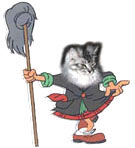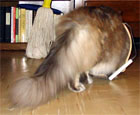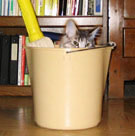Vol. 1, No. 46
Table of Contents
Assist Feeding – Surgery, A Tough Decision
Feline Nutrition – Special-Diet Foods
Pro-Active Cat Care – Did You Know.?
Kitty Potpourri – Let’s Clean House, Part I
Dr. Ed, DVM – Dr. Ed’s Cats!
Assist Feeding – Surgery, A Tough Decision
by Kathy Fatheree
I can tend to be tough on myself. really tough. When I make a decision for one of my kitties that backfires and results in the kitty getting sick, hurt or worse. I’ll blame myself for years. I’m sure my body has aged beyond my years because of the extreme grief that I feel for a lost feline friend. This past week I read a sad story that reminded me of why I started my web site and this great newsletter that Garry and Dan faithfully and wonderfully hold up to my dreams and expectations. You see, this last week I read a story of a young male cat that stopped eating so they inserted a feeding tube. The beautiful kitty didn’t survive the surgery. My heart broke for this kitty and his family and I relived my terrible, similar experience.
Tube placement CAN be the positive turning point for a kitty in it’s battle to survive a terrible disease such as Feline hepatic lipidosis. if fact it may be the only chance for survival, however we must remember the grave danger that surgery itself presents.
- First, there is the anesthesia hurdle to get past. Anesthesia is indeed extremely safer that just 10 years ago, but it is still very dangerous, especially if kitty has any hidden medical conditions or stress that we do not know about. The surgery disclaimer that your vet will have you sign always mentions the possibility of death. Don’t quote me, but I think that cats over 7 years of age are getting into the high-risk age. Obesity is also a problem and raises the risk of death during surgery.
- There is the skill of the doctor and the assistants that we must trust unconditionally. How many surgeries of this type has the vet performed? Is the vet a surgeon? Some vets do nothing but specialize in surgery.
- We hear of textbook cases meaning that everything went as was taught in school, but then there are the other stories where unexpected complications were encountered. We tend to think that we are all made exactly the same on the inside, but we are similar in generalities only. Veins, muscles, fat, and organs all have slightly different shapes and paths. surgery is not an exact science.
- Then we have to wonder what condition our kitty is in health wise. Is kitty hydrated, are the electrolytes balanced, the vitamin and mineral levels where we expect? If a kitty hasn’t been eating for several days, surgery can be very hard on the system. Can the vet syringe feed or finger feed your kitty for several days before the surgery to build up strength? Can they provide IV fluids during the surgery to keep the body hydrated and make it easier to flush the anesthesia out of the system after the surgery?
- Is your kitty stressed or calm? What can you do to provide a calm environment to allow plenty of rest before surgery? Sleep is of paramount importance for reducing stress and for enhancing healing.
Surgery is not to be taken lightly and it is something that you will really want to think about and discuss completely. Take every extra step that you can to prepare your cat for surgery.
REMEMBER, you know your cat the best so don’t hesitate to talk to your vet about anything that makes you wonder if your cat is prepared for surgery. For example, your cat may look alert at the office, but yet you know he or she is listless at home. this would be something to talk about in detail with your vet. Find out everything that you AND your vet can do to ensure that your kitty has the greatest possible chance of surviving surgery.
Feline Nutrition – Special-Diet Foods
by Garry White
Someone asked me recently: “What’s the best non-renal food for a CRF cat?” I was tempted to pull a Freud and answer with a question of my own: “What’s the best new car for under $25?” But I didn’t; I gave the best answer I could.with more warnings than answer. Unless extreme caution is used, this can be a very dangerous game to play, and I warned the questioner as much. Cat foods, per se, are designed for healthy cats, and obviously cats with various conditions cannot tolerate many of the nutrients, proteins, and other elements found in “normal” foods.
A few weeks ago, I talked about paying closer attention to the calorie (energy) level of foods, but with ailing cats it’s imperative that we also pay strictest attention to those minute nutrient levels as prescribed in the diet specific to the ailment. Most often, we’re faced with a requirement for food with multiple variants.high in this, low in that, and so on.
Experimenting can be dangerous: On one of the Yahoo lists recently, I noted a member telling another member that she had stumbled across a great low-phosphorous food for CRF kitties, was feeding it to her own CRF kitty, and recommended the other gal do the same. Nosey me, I crunched a few numbers and nearly fainted! Indeed, the phosphorous level wasn’t too bad.it was 0.67%, and anything around or below 0.50% is acceptable for a CRF cat. But that’s where she stopped: Protein was nearly triple that which is recommended for a renal kitty, and calcium and sodium were up in the clouds! This is what can happen if we don’t look at the whole, bigger picture, and regardless how well intended and/or how much Kitty loves the food, the results can be disastrous.
Perhaps in time there’ll be a simple, uncomplicated way for us to ask: “What’s the best food for a diabetic cat?” and get a readable list in return. But for now, we’re stuck with having to track down those illusive little digits manually. And that we must do with unwavering diligence.
A question always pops up here: “But how do we know what’s good; what’s the standard we should refer to?” To that I say develop your own standards by doing some basic research on several of the most well known, established and proven brands that cater to Kitty’s ailment. If your research shows, for example, that phos ranges from 0.40% to 0.65% with the better foods for that particular diet, then your standard for phos is around 0.50%. Then do this with each other special diet requirement, and you have your list for comparison. It’s a little bit of work, and it’s not a flawless approach.but it’s far safer than guessing, or following blindly what are often unqualified, dangerous recommendations. Typically, I don’t ask vets or manufacturers, because they may have a natural bias toward the product they sell or manufacture.
ProActive Cat Care – Did You Know.?
by Garry White
- There are about 100 distinct breeds of domestic cats.
- In ancient Egypt.killing a cat was a crime punishable by death.
- The first cat show on record was held at the Crystal Palace, in London.in 1871.
- Cats cannot taste sweets.
- Cats sleep, on average, 16-18 hours every day.
- Besides smelling with their nose, cats can smell with another organ (located in the upper roof of the mouth) called the Jacobson’s Organ
- Humans have 206 bones, cats have 230.
- Female cats reach sexual maturity at about 6-10 months of age.males take a bit longer.
- About 37% of homes today have at least 1 cat.
- The official name for a cat-lover is Ailurophile.
- A domestic cat can run at speeds up to 31 MPH!
- Blue-eyed, white cats are prone to deafness.
- The most expensive cats seem to be Bengal cats, which average in price between $1000-$9000. Cato, a 2nd. Generation Bengal, sold in London in 1998 for the paltry sum of $41,435.what a deal!
- Largest recorded number of cats born to a single Mom in one lifetime is 420.
- Cats have 3 eyelids.
- Daniel Boone had a cat named Bluegrass.
- Giraffes, camels, and cats.are the only 4-legged creatures that move both legs on the same side when they walk.
- The patterns on a cat’s nose-pad are as unique to every cat as fingerprints are to humans.
- Napolean Bonaparte was deathly afraid of cats.
- Digitigrade is the term used to describe how cats walk.on their claws, not on their paws.
- Cats purr at 26 cycles per second.the same as an idling diesel engine. Varooom!
- Cats have more than a hundred distinct vocal sounds; dogs have about ten.
- A group of cats is called a “clowder”.
- In ancient Egypt, when a cat died, people shaved off their eyebrows in respect.
- The “catgut” formerly used in tennis rackets came from sheep, hogs, and horses.
- Theodore Roosevelt’s cat, Slippers, was allowed to attend diplomatic dinners.
- Kittens are born both blind and deaf.
- A cat in NY fell 27 stories off a skyscraper.and lived!
- A cat’s amazing homing ability is actually based on its biological clock, the angle of the sun, and the earth’s magnetic field.
- The average cat-food meal is equivalent to about 5 mice.
Kitty Potpourri – Let’s Clean House, Part I
by Dan Malenski
General housecleaning is not a subject near and dear to all of us, but it is a task that must be accomplished from time to time in order to maintain a healthy environment for ourselves and our furry companions. Cleaning house in this household is never done without supervision because as soon as I gather up the mop and bucket,and start the cleaning process, the girls always manage to come out from the woodwork in order to watch and insure that I do a good job. I am just going to focus on general housecleaning and not on household hazards, as the latter is another subject that would have to be discussed at great length.
start the cleaning process, the girls always manage to come out from the woodwork in order to watch and insure that I do a good job. I am just going to focus on general housecleaning and not on household hazards, as the latter is another subject that would have to be discussed at great length.
Cats, in general, are less susceptible to outright poisoning than d*gs because of their discriminating nature, but they are more subject to harm from household chemicals from exposure due to their grooming habits, as cats will clean even the bottom of their paws. The following list of items was condensed from the ASPCA’s Animal Poison Control Center:
- Do not allow your cat to be exposed to any product containing detergents and/or deodorizers, which includes liquid potpourri (no relation to this article!), fabric softener, and even those dryer sheets you toss in with your wet clothes.
- Do not use toilet bowl cleaners or deodorizers, especially those that drop into the tank in the chance that your cat may decide to drink from it or a fall in during a raucous play session. Do not count on the lid for protection, as eventually, someone may forget to close it.
- Do avoid pine or citrus-based cleaners because the oils they contain may be dangerous to cats. Moreover, many common general use household cleaners and disinfectants contain chemicals hazardous to cats and should not be used on surfaces unless they are rinsed well.
Many formulas for safe solutions exist that will be very effective from cleaning your kitchen floor to removing soap scum from your shower stall. Amanda is already rolling her eyes, so I will not get into the various formulas for such solutions, because we will be talking about some of the more popular formulas next week. If you must use commercial cleaning products, there are ones that are safe for cats, but they may not be as abundant as the others; however, you will be able to find them with a bit of effort, some in your local supermarket. Just one example is Murphy’s Oil Soap&trade, a product based on pure soap, which I use for general floor cleaning.  It is available in all supermarkets, and Melissa just reminded me that it could also be purchased in gallon containers at nearly all home centers at a greatly reduced price. Amanda adds that the money saved may be put towards gift giving for the upcoming holiday season – hum, I wonder what she has in mind?
It is available in all supermarkets, and Melissa just reminded me that it could also be purchased in gallon containers at nearly all home centers at a greatly reduced price. Amanda adds that the money saved may be put towards gift giving for the upcoming holiday season – hum, I wonder what she has in mind?
For general cleaning, there are a few products that are considered safe to use around cats and other small animals and are available in supermarkets and home centers. We will be discussing some of these products next week. They are too numerous to mention, but let common sense be your guide, and if in doubt, then don’t use it. After choosing a product, even those deemed safe for cats and other small animals, be sure to store them out of reach and always follow the instructions for diluting them, as some may be toxic to cats in their concentrated form.
products next week. They are too numerous to mention, but let common sense be your guide, and if in doubt, then don’t use it. After choosing a product, even those deemed safe for cats and other small animals, be sure to store them out of reach and always follow the instructions for diluting them, as some may be toxic to cats in their concentrated form.
Finally, if you are planning to do some serious housecleaning, your cats should be temporarily relocated to an adjacent state or province so that you may actually get some work done! As the photographs suggest, particularly the last two, housecleaning is the farthest thing from their minds.
Dr. Ed, DVM – Dr. Ed’s Cats!
by Edward A. Dimmick, DVM
My Cat’s bios:
Simba – 12 year old cream tabby NM DSH; originally from upstate New York, his first owner took him to Africa on a Peace Corps tour, where he spent his days stalking the veldt and facing down cape dogs. (His name means ‘lion’ and, yes, it was given before that Disney movie came out.) Simba’s owner then took employment at Tufts; in 1997 she had to find him a new home when she moved back to New York and her folks wouldn’t allow another cat. Simba spent two years at Alpha Psi dodging pit bulls inside and coyotes outside, but came through without a scratch; he also went through about a dozen collars. Now a respectable older gentleman, he keeps younger cats in line despite a bum eye and recurrent stomatitis. Little secret: he loves any kind of cheese.
Jupiter – 3 year old grey/brown tabby NM DSH; from a litter of four kittens in foster care. Jupiter was the last one off the bottle and just too adorable to give up, so I kept him. He’s named after the planet for being large, round, and striped. Jupiter is also very jovial, unless cars or dogs are involved; he was taught a healthy caution for both at an early age. As a kitten he earned the nickname ‘bird dog’ for stealing food, and once crawled into a pizza box with a fresh pizza in it. Jupiter has never caught an animal in his life, but pounces on and devours grass. He hasn’t quite figured out that 16-pound cats don’t nurse. Little secret; he loves to sit on shoulders but isn’t too good at hanging on…
Disclaimer: Kathy Fatheree is not at all a medical expert. Contents of this web site are a collection of Kathy’s assist feeding experiences as well as the experiences of other cat owners who have assist fed their cats. While every effort has been made to ensure the accuracy of the information, Kathy Fatheree or anyone associated with this web site cannot be held responsible for anything that may happen as a result of using the information on this site.
